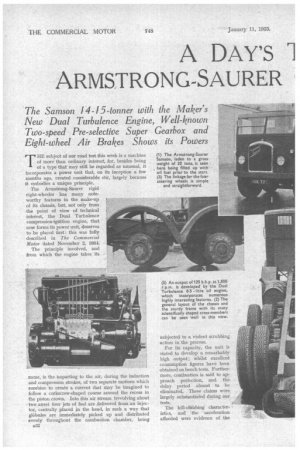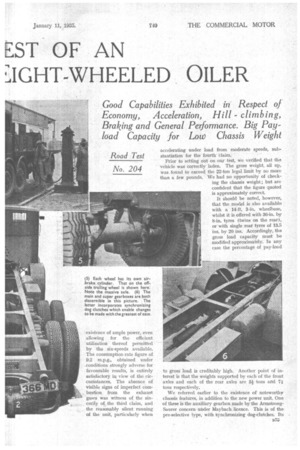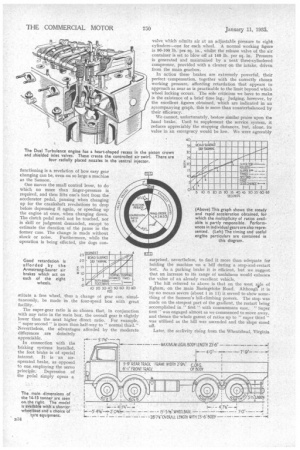A DAY'S ST OF AN ARMSTRONG-SAURER
Page 50

Page 51

Page 52

Page 53

If you've noticed an error in this article please click here to report it so we can fix it.
7IGHT-WHEELED OILER THE subject of our road test this week is a machine of more than ordinary interest, for, besides being of a type that may still be regarded as unusual, it incorporates a power unit that, on its inception a few months ago, created considerable stir, largely because it embodies a unique principle.
The Armstrong-Saurer rigid eight-wheeler has many noteworthy features in the make-up of its chassis, but, not only from the point of view of technical interest, the Dual Turbulence compression-ignition engine, that now forms its power unit, deserves to be placed first: this was fully described in The Commercial Motor dated November 2, 1934.
The principle involved, and from which the engine takes its
name, is the imparting to the air, during the induction and compression strokes, of two separate motions which combine to create a current that may be imagined to follow a corkscrew-shaped course around the recess in the piston crown. Into this air stream (revolving about two axes) four jets of fuel are delivered from an injector, centrally placed in the head, in such a way that glithules are immediately picked up and distributed evenly throughout the combustion chamber, being subjected to a violent scrubbing action in the process.
For its capacity, the unit is Mated to develop a remarkably high output; whilst excellent consumption figures have been obtained on bench tests. Furthermore, combustion is said to approach perfection, and the delay period almost to be eliminated. These claims were largely substantiated during our tests.
The hill-climbing characteristics, and 'the acceleration afforded were evidence of the
existence of ample power, even allowing for the efficient utilization thereof permitted by the six-speeds available. The consumption-rate figure of 9.2 m.p.g., obtained under conditions strongly adverse for favourable results, is entirely satisfactory ire view of the circumstances. The absence of visible signs of imperfect combustiori. from the exhaust gases was witness of the sincerity of the third claim, and the reasonably silent running of the unit, particularly when
accelerating under load from moderate speeds, substantiation for the fourth claim.
'Prior to setting out on -our test, we verified that the vehicle was correctly laden. The gross weight, all up, Was found to exceed the 22-tort legal limit by no more than a few pounds, We had no opportunity of checking the chassis weight; but are confident that the figure quoted is approximately correct.
It should be noted, however, that the model is also available with a 14-ft. 3-in. wheelbase, whilst it is offered with 36-in. by 8-in. tyres (twins on the rear), or with single rear tyres of 13.5 ins. by 20 ins. Accordingly, the gross load capacity must be modified approximately. In any case the percentage of pay-load
to gross load is creditably high. Another point of interest is that the weights supported by each of the front axles and each of the rear axles are 3-1tons and tons respectively.
We referred earlier to the existence of noteworthy chassis features, in addition to the new power unit. One of these is the auxiliary gearbox. made by the ArmstrongSaurer concern under Maybach licence. This is of the pre-selective type, with Synchronizing dog-clutches. Its functioning is a revelation of how easy gear changing can be, even on so large a machine as the Samson.
One moves the small control lever, to do which no more than finger-pressure is required, and then lifts one's foot from the accelerator pedal, pausing when changing up for the crankshaft revolutions to drop before depressing it again, or speeding up the engine at once, when changing down. The clutch pedal need not be touched, nor is skill or judgment demanded, except to estimate the duration of the pause in the former case. The change is made without shock or noise. Furthermore, while the operation is being effected, the dogs con stitute a free wheel, taneously, be made facility.
The super-gear ratio is so chosen that, in conjunction with any ratio in the main box, the overall gear is slightly lower than the next higher direct ratio. For example, " super second " is more than half-way to "normal third." Nevertheless, the advantages afforded by the moderate differences are definitely appreciable.
In connection with the braking systems installed, the foot brake is of special interest. It is an airoperated brake, as opposed to one employing the servo principle. Depression of the pedal simply opens a
The main dimensions of , the 14-15 tonner are seen on the right. The model is available with a shorter wheelbase and a choke of tyre equipment. 3334
valve which admits air at an adjustable pressure to eight cylinders—one for each wheel. A normal working figure is 90-100 lb, pee sq. in., whilst the release valve of the air container is set to blow off at 140 lb. per sq. in. Pressure is generated and maintained by a neat three-cylindered compressor, provided with a cleaner on the intake, driven from the main gearbox.
In action these brakes are extremely powerful, their perfect compensation, together with the correctly chosen working pressure, affording retardation that appears to approach as near as is practicable to the limit beyond which wheel locking occurs. The sole criticism we have to make is the existence of a brief time lag., Judging, however, by the excellent figures obtained, which are indicated in an accompanying graph, this is more than counterbalanced by their efficiency.
We cannot, unfortunately, bestow similar praise upon the hand brake. Used to supplement the service system, it reduces appreciably the stopping distances, but, alone, its value in an emergency would be low. We were agreeably surprised, nevertheless, to find it more than adequate for holding the machine on a hill during a stop-and-restart test.. As a parking brake it is efficient, but we suggest that an increase to its range of usefulness would enhance the value of an already excellent vehicle.
The hill referred to above is that on the west sipcle of Egham, on the main Basingstoke Road. Although it is by no means severe (about 1 in 11) it served to show something of the Samson's hill-climbing powers. The stop was made on the steepest part of the gradient, the restart being accomplished in " first " with consummate ease, " Super first " was engaged almost as we commenced to move away, and thence the whole gamut of ratios up to "super third" was utilized as the hill was ascended and the slope eased off.
Later, the acclivity rising from the Wheatsheaf, Virginia Water, was observed. :About two-thirds of a mile in length, this was climbed in fourth gear, and the ascent occupied 1 min. 6' secs. The speed of' the vehicle never fell below 18 m.p.h. • • • Both these' hills were included 'in' the fuel-consumption test, as was the negotiation of the narrow, crowded streets of Staines and Eghain, and the large number of stops necessitated by the traffic-signal lamps on the Great West Road and elsewhere.
The point at which we turned, in this consumption test, to retrace our tracks to the starting point—the ArmstrongSaurer Works on the Great West Road—was at the sufemit of the last of the hills before the road runs down into Sunningdate.Thus, in. addition to the climbs mentioned, there was some further collar work while traversing this stretch of the route. Our cruising speed, whenever conditions permitted, was about 25 m.p.h.
With a lighter vehicle, repeated stopping and restarting would be of little consequence, even in a' consumption test, but when a mass of 22 tons has to be put in motion each time, the effect thereof upon the quantity of fuel consumed is by no means negligible. For town work and shortdistance runs, such a machine as the Armstrong-Saurer Samson probably would not be used. Its sphere of usefulness is rather concerned with the carrying of big loads for considerable distances. Therefore, operators who base cost calculations on the figure we obtained, maydo so on the sure assumption that a big margin of safety exists.
Outside the thickly trafficked areas and on tolerably level main roads.the return of 9.2 m.p.g. published in the accompanying panel would undoubtedly be bettered very appreciably.
A spell at the wheel convinced us, even more than the timed acceleration tests, that the Dual Turbulence engine possesses liveliness more associated with the petrol than the oil unit, whilst this characteristic was almost over shadowed by the absolute simplicity of super-gear, changing, , The natural hesitancy, felt almost without exception by a driver on a strange machine, with regard to the gearchange, is, on the Armstrong-Saurer, replaced by an eagerness for an opportunity of making use of the higher or lower ratio afforded by the super box.
The steering, too, of this big vehicle calls for no great muscular effort. We have, on previous occasions, fruitlessly speculated as to the theoretical explanation of the phenomenon of lighter steering with duplication of front wheels and increased loading, but, whatever it may be, every time we handle vehicles of the four-steering-wheel variety, the more we are impressed by the gain in this respect that is afforded.
There is also to be considered the improved road-holding characteristics of the type. That this exists is an unquestionable fact, and it is obtainable without appreciably sacrificing manceuvrability.
It will be observed that, in the tabulated particulars at the top of this page, a maximum road speed of 32 m.p.h. is given in super fourth gear. This figure was supplied by Armstrong-Saurer Commercial Vehicles, Ltd., and does not agree with our actual experience, for a maximum in excess of 35 m.p.h. was obtained during one acceleration test. Higher speeds than those stated were also obtained in " fourth " and "super third." The probable explanation is that on the demonstration machine the governor is set to permit slightly higher revolutions than would be the case on a standard Model.
Incorporating so many of the most modern features of commercial-vehicle design, carrying a reputation too' high to jeopardize by including in the specification untried units, and embodying numerous details desirable for economic and reliable operation, this machine struck us as one of the best in its class, and likely still further to improve the Armstrong-Saurer name.




































































































